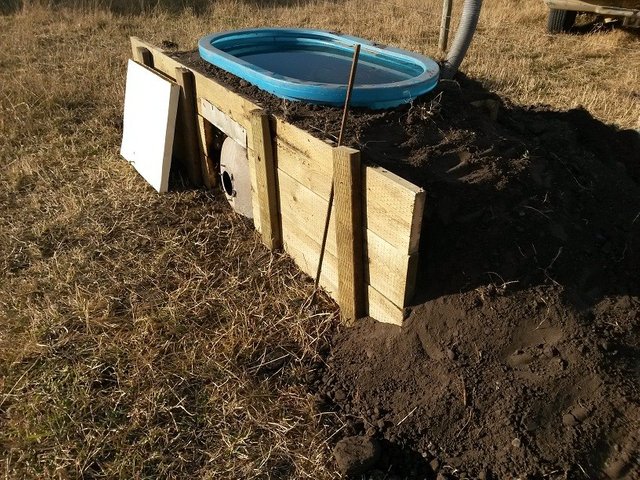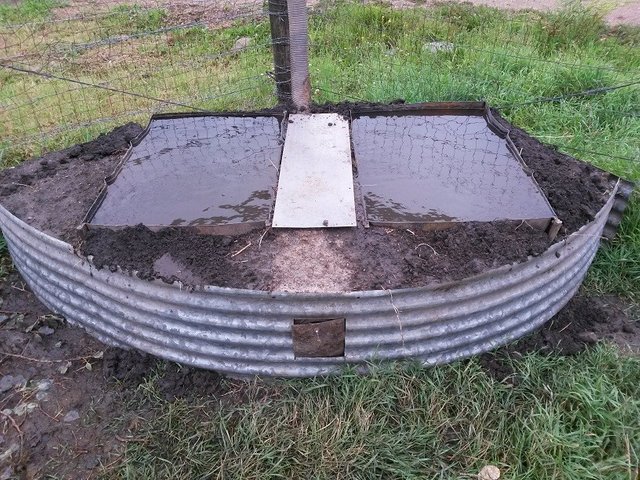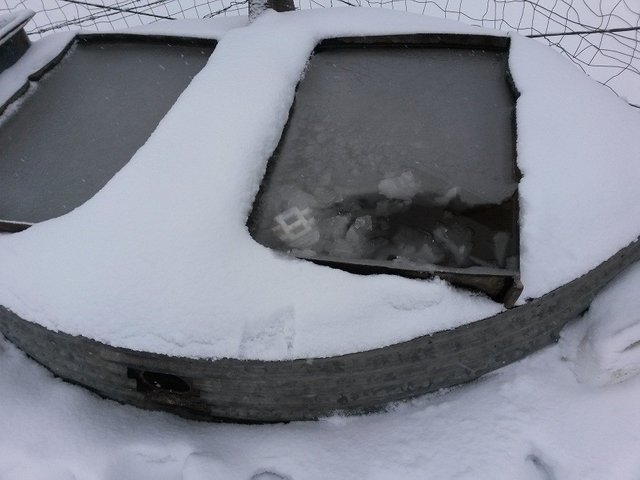Thermal Mass stock tank heater
I could not find any info on line, so I had to just invent the darn thing. The problem we ran into was keeping the water for the goats from freezing, especially during the cold snaps where temperatures can get as low as -40C/-40F. Then I remembered a story that dad told me where farmers used to take old cream pails, put a bit of sand in the bottom so that they floated low in the water and burn fires in them. I decided to use fire but instead heat up the thermal mass of the dirt and water using a stove instead. So I went shopping at the local transfer station and found an old water pressure tank and converted it into a stove, which you can see under the tank in the first picture. I then buried it under soil and put a plastic stock tank on top. Yes, I know, plastic melts. The idea was to keep water in the tank which would prevent melting.

Thermal mass stock tank heater - Version 1.0
It worked well, up until we took on two cows for some friends of ours. Turns out cows can drink 50 gallons of water in a shot, which emptied the tank and melted it. Sighhhh. Okay. Need something that won't melt. So back to the drawing board.

Thermal Mass stock tank heater - Version 2.0
This version is all metal, so no more melting! lol The stove is buried in the thermal mass, accessible through that square door in the front. I start the fire there and it then heats up the water and the earth. I used an old metal barrel and burned it clean with a propane torch, just to make sure there were no contaminates in the barrel.

When it is cold out, I can keep the water from freezing. I burn the stove for about 4-5 hours. That melts any ice, heats up the water slightly, not even close enough to burn the animals, and it heats up the thermal mass of the dirt under the tanks. We cover it at night and this will keep liquid water for three days before I had to do another burn. Works FANTASTIC!!!
That's ingenious! We've found that the internet is pretty amazing in helping to learn to do things but there are still things that we can't find and we have to re-invent. Kind of 'been there, got the t-shirt' then redo it all differently!
Indeed. Lots of ideas out there, but still requires some creativity to tweak the ideas so that they work within your own environment and fits within ones skill set too. I've also found some ideas seem like good ideas but with more experience, proves not so good. lol
Truth! When we first moved to our place the belt on our water generator (electrical) kept wearing so Doug carefully replaced it with a chain drive. Turns out chains stretch pretty quickly and we couldn't tighten it enough to make it work efficiently. Doug had to rework it again (in early winter - brrrr!), taking the chain drive off and replacing the belt drive again. We got a new generator that year which doesn't wear on the belt so much and have only had to replace it a couple times in ~ the last 8-12 years as opposed to every 2-3 months.
I remember on the older farm implements that there was always an idler pulley or wheel to keep chains and belts tight. The idler had a spring on it to keep the tension. Makes it easier than having to tighten it on a regular basis. I'm not familiar with your setup. Do you use anything like this?
There is some latitude for adjustment but it is a manual process, not a self-monitoring one like a spring might do.

Well done you! I gather you aren't living in Tahiti? Steem on homesteader!
Thank you. We live north of the 54 parallel about 2 hours north of the city commonly called Edmonton, Alberta. We have about 88 frost free days here and can experience some very extreme temperatures in the winter time.
I love Canada whatever the weather although haven't experienced extremes as when I visited it was always on a press trip and a holiday tucked on the end and usually in clemtn weather! Roll on summer eh? Our winter is not very far away. Followuing you to see how you get on. Happy Steeming!
That's an excellent idea!
Thank you. Necessity is the mother of invention! <3 When living off grid, we don't have the power to run electric stock tank heaters. So we had to find other ways. This works well for us.